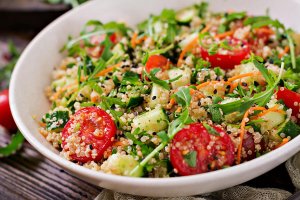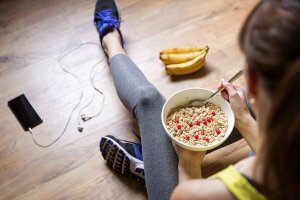Vegan Diet in Athletes, is it Possible?

The Merriam-Webster Dictionary defines the word vegan as “a strict vegetarian who consumes no food (such as meat, eggs, or dairy products) that comes from animals”. Also, it adds that someone who follows a vegan diet, “abstains from using animal products (such as leather)”.
There are different types of diets that are quite similar to each other: vegan, vegetarian, ovo-lacto vegetarian, flexitarian diet, etc. Today we’ll explain the first option and try to answer the question: is the vegan diet compatible with sports?
Preliminary definitions of the vegan diet
These are the different diets for which a person can choose:
- Omnivorous: people who consume everything.
- Pescetarianism: people who only eat seafood as their meat intake.
- Ovo-lacto vegetarian: doesn’t include meat or fish, but it does include dairy products and eggs.
- Lacto vegetarian: people avoid eating eggs, meat, and fish, but do eat cheese and milk.
- Ovo vegetarian: people who don’t consume dairy, meat or fish, but do eat eggs.
- Strict vegetarian: excludes all animal products and derivatives, including honey, eggs, and dairy products.
- Vegan: eliminates the same food groups as the vegetarian diet and, in addition, applies it to their lifestyle. They exclude, for example, the use of animal skins.
Evolution of the new food trends
The vegan diet is on the rise. In the 2011 National Survey of Spanish Dietary Intake, it was established that 1.5 percent of people didn’t eat meat or fish (without specifying what type of regime they had). This figure would be equivalent to 700 thousand vegetarian people.
In October 2014, a cross-sectional nutritional epidemiological study called the Nutrition Survey of the Community of Madrid (EN UCAM) was published.
For this study, researchers asked about the follow-up of special diets, such as a low-salt diet, gluten-free or lactose-free. To this question, 27 people responded that they followed a vegetarian diet. This represents 1.7 percent of the sample (n = 1553).
On the other hand, The Green Revolution report was prepared by the Lantern consultancy service in 2017. The study was carried out through two thousand telephone surveys that concluded that 7.7 percent of the population considers itself vegan.

Out of that 7.7 percent, 0.2 percent are vegans, 1.3 percent are vegetarians and 6.3 percent are flexitarians. Flexitarians are considered those who mainly follow a vegetarian diet but show sporadic consumption of meat or fish.
Of the motivations to opt for this lifestyle, 57 percent of the interviewees claimed ethical and environmental reasons. Meanwhile, 21 percent claimed reasons for sustainability and ecology, while health was the main concern of 17 percent.
Finally, in November 2018, a report on new food trends was published by the IPSOS consultancy. This report indicated that, although the most common diet worldwide is the omnivore, more than a tenth of the population follows diets without meat, but that may include fish.
Planning a vegan diet
When planning a vegan diet, one must take into account individual tolerances. The food sources that will be discussed below are exclusively vegan.
Food groups in the vegetarian diet
As in other dietary guidelines, vegetables and fruits should be the main food consumed. These must be present, either raw or cooked, in a large proportion. Vegetables provide the necessary vitamins, minerals, and nutrients that will make your diet truly balanced.
Grains and cereals must also be present, such as corn or oatmeal. Cereals are a great source of energy, complex carbohydrates, fiber, iron and vitamins of group B.
If you compliment your meals with quinoa, you’ll enjoy an even higher percentage of nutrients. Quinoa has a higher proportion of protein (14 g per 100 g of crude product) than other cereals such as rice (7 g per 100 g of crude product).

On the other hand, fruits are a great source of vitamins, minerals, and fiber. If you’re an athlete contemplating the idea of going vegan, you’ll have to eat plenty of fruit.
Similarly, fats and fatty foods play an important role for vegans, as it’s vital to ensure a correct supply of omega-3 oils. The main source of these fatty acids is fish. As vegans will not eat fish, then people wanting to follow this diet must obtain fatty acids from vegetables.
Nuts, seeds, and avocados are good sources of omega-3. For cooking, the most recommended fat is virgin olive oil.
As for proteins, the main source is legumes, followed by nuts and seeds. Other sources of vegetable protein are:
- Tofu, a form of liquefied soy.
- Wheat gluten. Be careful! We must take special care for those with celiac disease.
- Soybeans or chickpeas fermented with a fungus.
- Textured soybean flour that’s used as a substitute for minced meat in dishes such as bolognese spaghetti.
- Quorn, a microprotein obtained from the fermentation of a fungus.
Vegan diet in athletes
The main ‘problem’ of a vegan diet for an athlete is to meet the needs of proteins. The minimum protein requirements for vegans are 1.1 g/kg. Of course, it’ll depend on each athlete and their specific nutritional needs.

In athletes, the requirements are even greater, and it’s necessary to cover at least 1.3 g/kg of weight. Ideally, a person should consume 1.5-1.6 g/kg of meat per day. An example of a diet that meets the requirements (1.3g/kg weight/day) for a vegan male athlete of 65-70 kg would be the following:
- Breakfast: oat porridge, 50 g of soy drink (15 g protein).
- Snack: 2 soy yogurts (10 g protein).
- Lunch: 100 g of legume (1 pot) with vegetables (25 g protein).
- Snack: 2 pieces of fruit and a handful of nuts (5 g protein).
- Dinner: 150 g of tofu + vegetables (30 g of protein).
In total, this daily plan has a total of 85 grams of protein. As seen in the example, a well-planned vegan diet is compatible with sports.
Of course, we mustn’t forget the importance of B12 supplementation for these individuals. In case you’re looking for specific planning, go and visit a nutritionist.
The Merriam-Webster Dictionary defines the word vegan as “a strict vegetarian who consumes no food (such as meat, eggs, or dairy products) that comes from animals”. Also, it adds that someone who follows a vegan diet, “abstains from using animal products (such as leather)”.
There are different types of diets that are quite similar to each other: vegan, vegetarian, ovo-lacto vegetarian, flexitarian diet, etc. Today we’ll explain the first option and try to answer the question: is the vegan diet compatible with sports?
Preliminary definitions of the vegan diet
These are the different diets for which a person can choose:
- Omnivorous: people who consume everything.
- Pescetarianism: people who only eat seafood as their meat intake.
- Ovo-lacto vegetarian: doesn’t include meat or fish, but it does include dairy products and eggs.
- Lacto vegetarian: people avoid eating eggs, meat, and fish, but do eat cheese and milk.
- Ovo vegetarian: people who don’t consume dairy, meat or fish, but do eat eggs.
- Strict vegetarian: excludes all animal products and derivatives, including honey, eggs, and dairy products.
- Vegan: eliminates the same food groups as the vegetarian diet and, in addition, applies it to their lifestyle. They exclude, for example, the use of animal skins.
Evolution of the new food trends
The vegan diet is on the rise. In the 2011 National Survey of Spanish Dietary Intake, it was established that 1.5 percent of people didn’t eat meat or fish (without specifying what type of regime they had). This figure would be equivalent to 700 thousand vegetarian people.
In October 2014, a cross-sectional nutritional epidemiological study called the Nutrition Survey of the Community of Madrid (EN UCAM) was published.
For this study, researchers asked about the follow-up of special diets, such as a low-salt diet, gluten-free or lactose-free. To this question, 27 people responded that they followed a vegetarian diet. This represents 1.7 percent of the sample (n = 1553).
On the other hand, The Green Revolution report was prepared by the Lantern consultancy service in 2017. The study was carried out through two thousand telephone surveys that concluded that 7.7 percent of the population considers itself vegan.

Out of that 7.7 percent, 0.2 percent are vegans, 1.3 percent are vegetarians and 6.3 percent are flexitarians. Flexitarians are considered those who mainly follow a vegetarian diet but show sporadic consumption of meat or fish.
Of the motivations to opt for this lifestyle, 57 percent of the interviewees claimed ethical and environmental reasons. Meanwhile, 21 percent claimed reasons for sustainability and ecology, while health was the main concern of 17 percent.
Finally, in November 2018, a report on new food trends was published by the IPSOS consultancy. This report indicated that, although the most common diet worldwide is the omnivore, more than a tenth of the population follows diets without meat, but that may include fish.
Planning a vegan diet
When planning a vegan diet, one must take into account individual tolerances. The food sources that will be discussed below are exclusively vegan.
Food groups in the vegetarian diet
As in other dietary guidelines, vegetables and fruits should be the main food consumed. These must be present, either raw or cooked, in a large proportion. Vegetables provide the necessary vitamins, minerals, and nutrients that will make your diet truly balanced.
Grains and cereals must also be present, such as corn or oatmeal. Cereals are a great source of energy, complex carbohydrates, fiber, iron and vitamins of group B.
If you compliment your meals with quinoa, you’ll enjoy an even higher percentage of nutrients. Quinoa has a higher proportion of protein (14 g per 100 g of crude product) than other cereals such as rice (7 g per 100 g of crude product).

On the other hand, fruits are a great source of vitamins, minerals, and fiber. If you’re an athlete contemplating the idea of going vegan, you’ll have to eat plenty of fruit.
Similarly, fats and fatty foods play an important role for vegans, as it’s vital to ensure a correct supply of omega-3 oils. The main source of these fatty acids is fish. As vegans will not eat fish, then people wanting to follow this diet must obtain fatty acids from vegetables.
Nuts, seeds, and avocados are good sources of omega-3. For cooking, the most recommended fat is virgin olive oil.
As for proteins, the main source is legumes, followed by nuts and seeds. Other sources of vegetable protein are:
- Tofu, a form of liquefied soy.
- Wheat gluten. Be careful! We must take special care for those with celiac disease.
- Soybeans or chickpeas fermented with a fungus.
- Textured soybean flour that’s used as a substitute for minced meat in dishes such as bolognese spaghetti.
- Quorn, a microprotein obtained from the fermentation of a fungus.
Vegan diet in athletes
The main ‘problem’ of a vegan diet for an athlete is to meet the needs of proteins. The minimum protein requirements for vegans are 1.1 g/kg. Of course, it’ll depend on each athlete and their specific nutritional needs.

In athletes, the requirements are even greater, and it’s necessary to cover at least 1.3 g/kg of weight. Ideally, a person should consume 1.5-1.6 g/kg of meat per day. An example of a diet that meets the requirements (1.3g/kg weight/day) for a vegan male athlete of 65-70 kg would be the following:
- Breakfast: oat porridge, 50 g of soy drink (15 g protein).
- Snack: 2 soy yogurts (10 g protein).
- Lunch: 100 g of legume (1 pot) with vegetables (25 g protein).
- Snack: 2 pieces of fruit and a handful of nuts (5 g protein).
- Dinner: 150 g of tofu + vegetables (30 g of protein).
In total, this daily plan has a total of 85 grams of protein. As seen in the example, a well-planned vegan diet is compatible with sports.
Of course, we mustn’t forget the importance of B12 supplementation for these individuals. In case you’re looking for specific planning, go and visit a nutritionist.
All cited sources were thoroughly reviewed by our team to ensure their quality, reliability, currency, and validity. The bibliography of this article was considered reliable and of academic or scientific accuracy.
- Ministerio de Sanidad, Servicios Sociales e Igualdad de España. Evaluación nutricional de la dieta española. Energía y macronutrientes. Sobre datos de la Encuesta Nacional de Ingesta Dietética (ENIDE). http://www.cibr.es/ka/apps/cibr/docs/estudio-enide-1.pdf
- Encuesta de nutrición de la Comunidad de Madrid. Documentos Técnicos de Salud Pública nº D137. Fundación Española de la Nutrición. http://www.aecosan.msssi.gob.es/AECOSAN/docs/documentos/nutricion/observatorio/ENUCAM_2014.pdf
- Andreu, M. J. (2015). Nutrición y salud en la dieta vegana. Universitat Oberta de Catalunya (UOC). Retrieved from http://openaccess.uoc.edu/webapps/o2/bitstream/10609/58407/3/fandreuiTFM211216.pdf
- Haub MD, Wells AM, Tarnopolsky MA, Campbell WW. Effect of protein source on resistive-training-induced changes in body composition and muscle size in older men. Am J Clin Nutr 2002; 76(3): 511-517
- Campbell WW, Barton ML, Jr., Cyr-Campbell D, Davey SL, Beard JL, Parise G, et al. Effects of an omnivorous diet compared with a lactoovovegetarian diet on resistance-training-induced changes in body composition and skeletal muscle in older men. Am J Clin Nutr 1999; 70(6): 1032-1039.
This text is provided for informational purposes only and does not replace consultation with a professional. If in doubt, consult your specialist.








